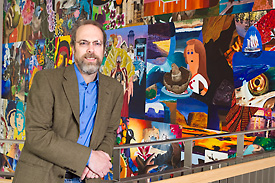More information
Businesses interested in displaying murals from Mark Tucker’s art class should contact Tucker at [email protected].
In Mark Tucker’s “Art in Public Places/Big Paintings” class, students aren’t limited by the size of a canvas.
“I think there is a sense of heroism in creating something that is larger than yourself,” says FestiFools founder Tucker, who led an art class in which students created murals in 2004-06 and is bringing the mural project back this fall. He’s also seeking area businesses willing to display them.
“It has to do with the power of scale, and that it is presented in a public place. The message has a tendency to frankly be more dramatic. I essentially use the mural as a tool to bring an entire class together for a common purpose.”
In 2007 Tucker, art director for the Lloyd Hall Scholars Program, put aside the mural element of his 15-week class. That’s when the class focus shifted to creating giant puppets and related art works to support FestiFools, which seeks to bring students and community volunteers together to create unique public art. Tucker says that while that work continues, this fall when the class returns he hopes to have a list of businesses that have agreed to show indoor murals created by his students.
Business owners will be asked to install a finished mural and host a public reception for the student artists in early December. Tucker says the idea to recruit businesses makes him “feel good about putting that energy back into the mural project.” He says business owners already are showing interest.
Tucker says he latched onto the idea of students creating a mural to motivate and inspire those who take the class, geared for non-art majors.

Mark Tucker, art director for the Lloyd Hall Scholars Program, this fall will revive a student mural project that last produced a mural at the Undergraduate Science Building. Photo by Daryl Marshke, U-M Photo Services.
“I wanted a mechanism to get students more interested in what they’re producing in the art class, as interested as they are in their other class work. I decided a public component to what they produced would be the best way to do it,” he says, adding that when work appears in public it has to reach a certain standard. “A mural also seemed a logical extension of paintings they were doing on a smaller scale.”
“It might be the only art course a student takes at U-M. It’s a journey that makes them much better creative thinkers — that’s the purpose of the course.”
His first class in 2004 produced a mural that was installed at the Lucky Kitchen Chinese Restaurant in Ann Arbor (since removed). A second was installed in 2005 at 4731 Gallery on Grand River in Detroit, and a third in 2006 at the Undergraduate Science Building atrium.
Weeks before students begin working on a mural, they take on exercises to understand and reproduce what they’re seeing. To develop visual literacy skills, Tucker says he likes to have students draw live models. “They can tell immediately if they’re not drawing the arms right, or if the fingers are out of proportion. Once you can master that it’s very empowering — you get the sense you can see so much better.”
He also covers color theory, asks students to replicate works by favorite artists, and presents some surrealist exercises. Towards the end of the course, for up to 24 students, the group works together on murals painted on canvas, at a large studio located in the Campus Safety Services Building on Kipke across from Crisler Arena. He doesn’t suggest a theme, leaving that to students who tend to slowly develop a message as the mural is being created.
Tucker says a mural stands out in comparison to other forms of communication. “Art assignments tend to get put away, rolled up under a bed. These mural projects really involve the community as well as the student. And for a business I think it’s an interesting connection to have with the university,” he says.

